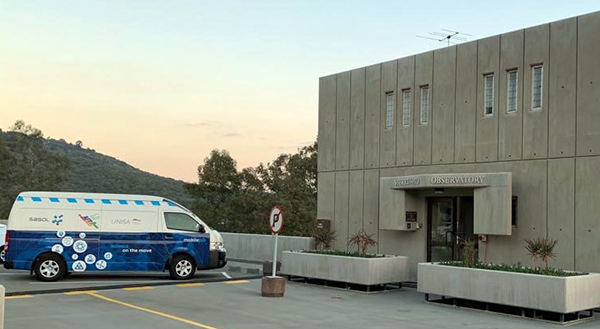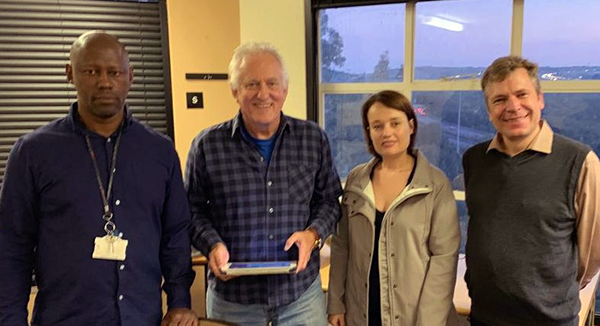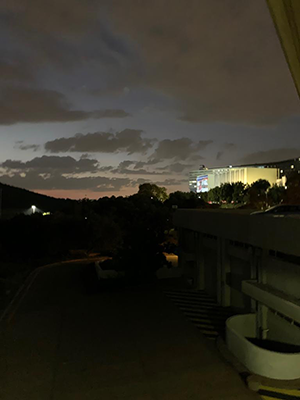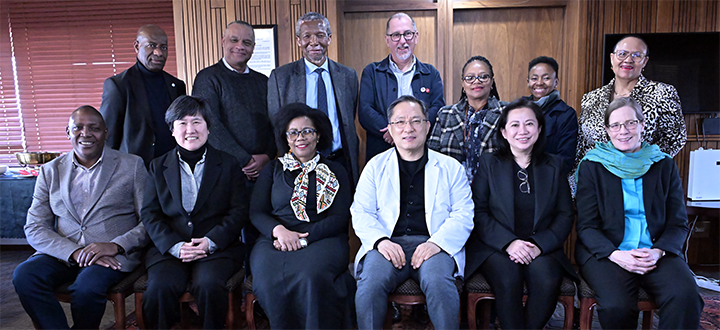I-SET
Mesmerised by ☆ ★ ☆

On the evenings of 7, 8 and 9 May 2019, the Astronomy Team of Inspired towards Science, Engineering, and Technology (I-SET), a community engagement flagship project of the College of Science, Engineering, and Technology (CSET), invited public to the Unisa Observatory to view the night sky.
For three evenings, four groups of up to eight persons could ascend the observatory landing and be mesmerised by the night sky for 45 minutes!

Zolile Mguda, Derck Smits, Andri Prozesky, and Mark Smith
 The first session started at 18:15 as the sun set and the moon appeared. The last session ended at 21:15. On arrival at the observatory on the Muckleneuk Campus, a group was introduced to the stars and the sky by Zolile Mguda, Mark Smith, and Andri Prozesky. Laser pointers and mobile telescopes transported all eyes to way beyond the earth. On the landing in the observatory, Derck Smits introduced and showed (and WOWed) each group:
The first session started at 18:15 as the sun set and the moon appeared. The last session ended at 21:15. On arrival at the observatory on the Muckleneuk Campus, a group was introduced to the stars and the sky by Zolile Mguda, Mark Smith, and Andri Prozesky. Laser pointers and mobile telescopes transported all eyes to way beyond the earth. On the landing in the observatory, Derck Smits introduced and showed (and WOWed) each group:
- The Moon
- The Orion Nebula, M42, an example of a young star-forming region that shows the cloud of gas from which the stars are forming
- Herschel’s Jewel Box is a young (only about 7 million years old) open cluster with some hot, bright stars that display different colours.
- Alpha Centauri is the brighter of the two pointers of the Southern Cross, and the nearest star to our Sun. It consists of two stars making up a binary system, both of which are very similar to our Sun.
- The Blue Planetary appears as a faint blob that disappears and then reappears. It is a planetary nebula that is a late stage of a sun-like star. Our Sun will become a planetary nebula in about five billion years.
- Omega Centauri is the largest known globular cluster circling our galaxy, the Milky Way. The stars in Omega Cen are about 12 billion years old, so probably the oldest objects our visitors have ever seen.
- The Sombrero Galaxy, M104, is a faint smudge as seen through our telescope but the light from this object has travelled for 80 million years before reaching one’s eye.
- For visitors in the last session, we were able to observe the bright disc of the planet Jupiter just above the horizon with its four Galilean moons lined up with the planet’s equator.
The I-SET and Observatory team thank Unisa for the amazing support and enthusiasm for the presentation of the night sky. Several other evenings are planned soon. Watch the Space! For more information you are welcome to contact Professor Derck Smits (smitsdp@unisa.ac.za ) or Dr Patricia Gouws (gouwspm@unisa.ac.za ).
Did you love this article? Click here to send us an email.
Hate it? Click here.
We’d like to know.
*By Patricia Gouws and Derck Smits
Inspired towards Science, Engineering, and Technology
Publish date: 2019-05-09 00:00:00.0


 Unisa wins bid to host IAMS General Assembly
Unisa wins bid to host IAMS General Assembly
 Cutting grass by day, pursuing Unisa studies by night
Cutting grass by day, pursuing Unisa studies by night
 Unisan’s research set to improve accident records management through AI
Unisan’s research set to improve accident records management through AI
 Koma e wetse: When tradition meets the harsh realities of modern livelihoods
Koma e wetse: When tradition meets the harsh realities of modern livelihoods
 Imbizo inspires youth
Imbizo inspires youth